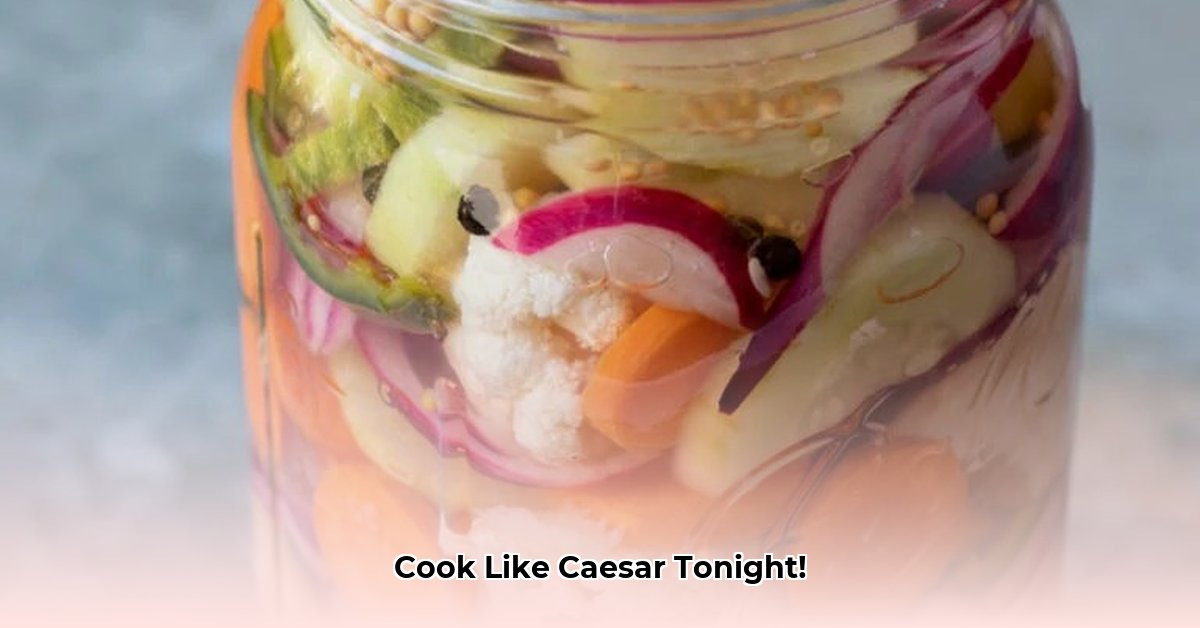Step back in time and unlock the culinary secrets of the Roman Empire! Have you ever wondered what delectable dishes graced the lavish banquets of emperors or provided sustenance to the average Roman citizen? Prepare to embark on a fascinating journey into ancient Roman cuisine, where bold, exciting flavors from antiquity are meticulously reimagined for your modern kitchen. Explore more with these valuable cooking recipes. This comprehensive guide will illuminate the captivating world of Roman food culture, from its foundational ingredients to its resourceful cooking philosophies. Forget dusty history books; we’re bringing the savory tastes enjoyed by figures like Caesar directly to your plate, painstakingly adapted with ingredients readily available at your local market.
Get ready to transform historical recipes, bridging the gap between hard-to-find ancient components and delicious, contemporary dishes. This exploration promises to tantalize your taste buds and impress your guests with a genuine taste of history that’s far simpler to create than you might imagine.
Decoding Ancient Roman Flavors: The Culinary DNA of an Empire
To truly master the art of cooking ancient Roman recipes, one must first understand their distinctive flavor profile and the ingenious methods employed by Roman chefs. Unlike modern cuisine, which often segregates sweet and savory, Roman dishes frequently blended these elements, creating complex and intriguing palates. Imagine a world where sugar was scarce, and fermentation was a cornerstone of flavor development. This resourcefulness, often stemming from a “cucina povera” (poor kitchen) philosophy, emphasized seasonality and making the most of every ingredient, a principle profoundly relevant to today’s focus on fresh, sustainable eating.
Essential Ingredients and Their Modern Counterparts
The backbone of authentic Roman flavors often relied on ingredients that, at first glance, might seem exotic or challenging to source today. However, with a dash of culinary creativity, clever substitutions can bring you remarkably close to the intended taste of historical Roman cuisine.
Garum (Fermented Fish Sauce): The Roman Umami Bomb
Garum was arguably the most ubiquitous condiment in the Roman world, a powerful fermented fish sauce that delivered an intense savory, umami punch. It infused everything from simple porridges to elaborate multi-course meals, acting as the ancient world’s equivalent of a universal flavor enhancer. The original production involved fermenting small fish, typically anchovies, heavily in salt under the sun for weeks or months. Its pungent, intensely savory liquid was foundational.
- Modern Swaps for Garum: For most modern palates, high-quality Asian fish sauce (such as those from Thailand or Vietnam) is the most effective and accessible substitute. Its production method and flavor profile closely mirror garum. Alternatively, anchovy paste can provide a concentrated salty, fishy essence. For a vegan option, consider using a combination of dried shiitake mushroom powder and seaweed flakes for a briny, savory depth.
Defrutum, Sapa, and Caroenum (Reduced Grape Syrups): Roman Sweeteners
Before refined sugar, the Romans extensively used grape-derived sweeteners. Defrutum, sapa, and caroenum were concentrated syrups created by boiling down grape juice to various degrees of thickness. These substances served not only as primary sweeteners but also as crucial flavor enhancers and effective preservatives, central to Roman food culture. While honey was also utilized, these grape syrups were distinct in their complex, often tart-sweet profiles.
- Modern Swaps for Grape Syrups: A homemade grape juice reduction is your best bet. Gently simmer high-quality grape juice (red or white) in a stainless-steel pot (crucially, never use lead, unlike some ancient practices, due to severe toxicity risks!) until it reduces by half (defrutum), three-quarters (sapa), or even more (caroenum). This process yields syrups with varying levels of sweetness and flavor intensity. Other alternatives include honey (preferably raw, local honey for natural sweetness), molasses (for deeper, more complex notes), or date syrup.
Passum (Raisin Wine): Sweetness with a Kick
Passum was a rich, sweet raisin wine, also a grape-derived product, that provided both sweetness and an alcoholic component to dishes. It was often incorporated into savory sauces and desserts.
- Modern Swaps for Passum: A sweet dessert wine, such as Vin Santo, Marsala, or a late-harvest Zinfandel, can serve as a functional substitute, offering both sweetness and a wine base. Alternatively, steep plump raisins in a small amount of dry white wine or grape juice to extract their natural sweetness and concentrated flavor, then use the liquid in your recipe.
Relive History: Three Quintessential Roman Recipes, Reimagined
Ready to channel your inner Roman gourmand? Here are three quintessential recipes ancient Rome enjoyed, carefully simplified and optimized for your contemporary kitchen, allowing you to access a truly authentic Roman flavor.
1. Moretum: The Roman Farmer’s Humble Cheese Spread
Imagine a simple, yet intensely flavorful spread that was a daily bread accompaniment for countless Romans, from farmers to city dwellers. Moretum offers a direct and delicious connection to the everyday life of the ancient world, embodying the resourceful spirit of Roman food culture. This versatile staple, traditionally pounded in a mortar, was enjoyed with almost every meal.
Modern Adaptation (Crafted for Contemporary Palates):
- Yields: Approximately 1 cup
- Prep time: 10 minutes
Chill time: 30 minutes (recommended)
Ingredients:
- 4 ounces fresh ricotta cheese (for creaminess, a modern twist on ancient fresh cheese)
- 2 ounces aged Pecorino Romano cheese, finely grated (for authentic Roman tang and saltiness)
- 3 cloves garlic, minced (for a pungent, bold kick)
- 1/4 cup fresh parsley, finely chopped
- 1/4 cup fresh mint, finely chopped (or a blend of mint and fresh oregano for aromatic depth)
- 3 tablespoons extra virgin olive oil, high quality (the “liquid gold” of ancient Rome)
- 1 tablespoon white wine vinegar (to brighten flavors, reminiscent of Roman acidity)
- 1/4 teaspoon freshly ground black pepper
- Pinch of sea salt (adjust to taste, as Pecorino Romano is salty)
Instructions:
Step 1: In a food processor, combine the ricotta cheese, grated Pecorino Romano, minced garlic, chopped parsley, and chopped mint (or oregano). Ensure all ingredients are nestled together for even processing.
Step 2: Add the extra virgin olive oil and white wine vinegar. Process the mixture on high until it transforms into a smooth, creamy, and visually appealing paste. If necessary, scrape down the sides of the bowl to ensure all ingredients are incorporated.
Step 3: Season with freshly ground black pepper and a pinch of sea salt. Pulse briefly to combine. Taste and adjust seasoning as needed, remembering that the flavors will meld and intensify as it chills.
Step 4: For optimal flavor development and a firmer, more spreadable consistency, transfer the Moretum to an airtight container and refrigerate for at least 30 minutes before serving. This allows the herbs and garlic to fully infuse the cheeses.
Step 5: Serve chilled or at room temperature. Enjoy this delightful historical taste with crusty artisan bread, thinly sliced cucumbers, or crisp crackers.Chef’s Notes & Variations:
- For an even more rustic texture, you can traditionally pound the ingredients in a large mortar and pestle.
- A small pinch of red pepper flakes offers a subtle, warming heat if you desire a spicier kick.
- Consider adding a tablespoon of toasted pine nuts for an added layer of texture and nutty flavor, a common element in Roman cooking.
2. Libum: A Roman “Cheesecake” of Ritual and Delight
Forget modern decadent cheesecakes; the Roman Libum offers a simpler, yet profoundly satisfying, baked cheese and honey treat. This dish provides a captivating glimpse into ancient culinary arts and their intertwining with daily life and religious practice. Historical records indicate that Libum held more than just culinary significance; this humble cake was frequently employed in religious ceremonies and offerings, symbolizing purity, gratitude, and abundance. It was often presented as an offering to household gods.
Modern Adaptation (Capturing Historical Essence with Ease):
- Yields: 1 small cake (serves 4-6)
- Prep time: 15 minutes
Bake time: 30-40 minutes
Ingredients:
- 1 cup fresh ricotta cheese (full-fat for richer texture)
- 1/2 cup raw honey (preferably local, for a nuanced sweetness echoing authentic Roman flavor)
- 1 large egg, lightly beaten
- 1/2 cup all-purpose flour, sifted (for a smooth, light texture)
- 1/4 teaspoon sea salt
- Optional: 1 fresh bay leaf (for a subtle, distinct ancient aroma; remove before serving)
- Extra honey for drizzling, and fresh figs or berries for serving
Instructions:
Step 1: Preheat your oven to 350°F (175°C). Lightly grease a 6-inch round baking dish or small pie plate with butter or olive oil. A springform pan will yield cleaner edges.
Step 2: In a medium-sized mixing bowl, combine the ricotta cheese, honey, and the lightly beaten egg. Whisk vigorously until the mixture is thoroughly blended, smooth, and homogenous.
Step 3: Gradually incorporate the sifted all-purpose flour and sea salt into the wet mixture. Stir gently with a spatula or wooden spoon until just combined, being careful not to overmix, which can toughen the texture. If using, gently fold in the fresh bay leaf now.
Step 4: Pour the Libum batter evenly into the prepared baking dish. Smooth the top with the back of a spoon or spatula for an even bake and golden crust.
Step 5: Bake for 30-40 minutes, or until the edges are golden brown and the center is set but still has a slight, delicate jiggle, much like a baked custard. A toothpick inserted near the center should come out clean.
Step 6: Remove from the oven and allow the Libum to cool in the pan on a wire rack for at least 15-20 minutes before attempting to slice. This allows the cake to firm up and flavors to fully develop.
Step 7: Serve warm or at room temperature. Drizzle generously with additional honey just before serving, and accompany with fresh figs, grapes, or berries for a truly Roman feast experience.Chef’s Notes & Variations:
- For a rustic, earthy flavor, substitute a portion of the all-purpose flour with whole wheat or spelt flour.
- A tiny pinch of ground black pepper or a whisper of cinnamon can add unexpected depth, reflecting the Roman love for spices in sweet dishes.
3. Puls: The Roman Soldier’s Hearty Barley Porridge
For the typical Roman, Puls was an incredibly affordable, filling, and satisfying meal, often forming the very base of their daily sustenance. This hearty and nourishing porridge was a staple for both Roman soldiers, who relied on its sustained energy, and common citizens, embodying the practical and robust side of Roman food culture. It was the ultimate comfort food, adaptable to whatever ingredients were at hand.
Modern Adaptation (Nutritional & Historically Relevant):
- Yields: 4 servings
- Prep time: 10 minutes (plus optional overnight soak)
Cook time: 45-60 minutes
Ingredients:
- 1 cup pearled barley, rinsed thoroughly
- 4 cups water or low-sodium vegetable broth (broth enhances flavor depth)
- 2 tablespoons extra virgin olive oil
- 1 medium yellow onion, finely chopped
- 1 stalk celery, finely diced (adds aromatic complexity)
- 1 medium carrot, finely diced (for sweetness and visual appeal)
- 1/2 teaspoon dried oregano or thyme (classic Roman herb flavors)
- Sea salt and freshly ground black pepper to taste
- Optional garnishes: crumbled Feta or Pecorino Romano cheese, fresh parsley, extra olive oil
Instructions:
Step 1: (Optional, for quicker cooking and creamier texture) Soak the rinsed pearled barley in cold water overnight. Drain thoroughly before proceeding.
Step 2: In a large, heavy-bottomed pot or Dutch oven, heat the 2 tablespoons of extra virgin olive oil over medium heat. Add the finely chopped yellow onion, diced celery, and diced carrot. Sauté gently, stirring occasionally, until the vegetables soften and the onion becomes translucent, about 7-10 minutes.
Step 3: Stir in the rinsed (and soaked, if applicable) barley and the dried oregano or thyme. Sauté for another 2 minutes, allowing the barley to lightly toast and absorb the aromatic flavors.
Step 4: Pour in the 4 cups of water or vegetable broth. Bring the mixture to a vigorous boil over high heat, stirring to prevent sticking.
Step 5: Once boiling, immediately reduce the heat to very low, cover the pot tightly, and let it simmer for 45-60 minutes (or 30-40 minutes if pre-soaked). The barley should become tender and have absorbed most of the liquid, creating a thick, creamy porridge. Stir occasionally during the last 15 minutes to prevent sticking.
Step 6: Remove the pot from the heat. Let the Puls rest, covered, for 5 minutes. This allows the barley to steam further and achieve optimal tenderness.
Step 7: Season generously with sea salt and freshly ground black pepper to taste. Stir well. Ladle into bowls and garnish with crumbled cheese, a sprinkle of fresh parsley, and a final drizzle of high-quality olive oil for enhanced flavor and richness.Chef’s Notes & Variations:
- For a heartier meal, incorporate cooked lentils or chickpeas during the last 15 minutes of simmering.
- A spoonful of garum substitute (fish sauce) during the final seasoning adds a burst of authentic umami, connecting this humble dish to the broader Roman culinary arts.
Perfect Pairings: Raising a Toast to Rome
To truly dine like a Roman, complement your meal with a thoughtfully selected wine. While ancient Roman wines differed significantly from modern varieties, often being richer, sweeter, and sometimes even spiced, contemporary pairings can beautifully harmonize with these historical dishes. A crisp white wine or a versatile dry rosé often proves an ideal companion.
| Recipe | Suggested Modern Wine Pairing | Why it Works |
|---|---|---|
| Moretum | Sauvignon Blanc or Pinot Grigio (crisp white) | Their bright acidity and citrus notes expertly cut through the richness of the cheese and beautifully elevate the fresh, vibrant herbs. |
| Libum | Moscato d’A’sti (lightly sparkling sweet white) or Vin Santo (sweet dessert wine) | These wines enhance the delicate, natural sweetness of the honey and provide a delightful, refreshing contrast to the cheese-based cake. |
| Puls (Barley Porridge) | Light-bodied Pinot Noir (red) or a dry Rosé (Provence style) | The subtle fruitiness of Pinot Noir or the refreshing crispness of a dry rosé complements the earthy flavors of the barley and any added vegetables. |
Future-Proofing Roman Cuisine: Adapting for the Contemporary Palate
Modern Roman cooking is not merely a historical re-enactment; it is a creative re-imagination of ancient ingredients and straightforward culinary methods for today’s diverse Roman palates and global culinary preferences. This contemporary approach places significant emphasis on utilizing fresh, seasonal ingredients, aligning seamlessly with current culinary trends like farm-to-table movements and ingredient-focused cooking.
The very essence of traditional Roman dishes lies in their “cucina povera” origins—a philosophy rooted in resourceful, simple cooking with minimal waste, making the most of what was available. This foundational principle translates seamlessly to today’s burgeoning emphasis on seasonal, locally sourced eating. Contemporary chefs and home cooks alike are embracing this sustainable philosophy, prioritizing fresh produce acquired from local farmers’ markets and community-supported agriculture (CSAs). This approach not only intensifies the flavors of homemade Roman food but also aligns perfectly with modern sustainability practices, honoring the principles often seen in the ancient Mediterranean diet.
Restaurants globally are actively exploring modern interpretations of ancient culinary arts, often by blending seasonal produce with intriguing new flavor combinations or utilizing contemporary cooking techniques to achieve textures and presentations unimaginable in antiquity. Meanwhile, food bloggers and culinary enthusiasts are delving deep into Roman food history, tirelessly showcasing modern versions and adding unique local twists to dishes.
For home cooks, embarking on this culinary journey is remarkably accessible. Start your voyage with approachable dishes like Cacio e Pepe (a foundational Roman pasta dish, though slightly later in its popular form than the recipes presented here) to familiarize yourself with core Roman tastes: the transformative power of cheese, pepper, and a rich, simple base.
Ultimately, reviving ancient Roman cuisine for the modern era is a testament to the timeless appeal of good food. It’s about celebrating ingenuity, understanding the power of simple ingredients, and embracing the joy of a Roman feast that transcends millennia. Gather your carefully chosen ingredients, unleash your creativity, and prepare to cook with flavors that would make Caesar proud, fortified by the indispensable advantage of modern safety standards and culinary innovation.










